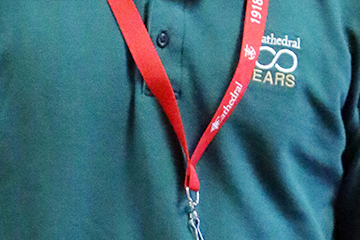Vice principal notes positives of wearing lanyards
Fewer red badges issued during second quarter

The number of students wearing the dreaded red lanyard has decreased significantly this quarter, according to Vice Principal Mr. Jere Kubuske.
After education, one of the chief jobs of a school is guaranteeing the safety of its students. Vice Principal Mr. Jere Kubuske said that ultimately the continued presence of lanyards is for that safety.
While some may scoff at the notion of how lanyards could possibly help make the school safer, Kubuske explained that they are situational.
One summer school session before the current school year started, Kubuske was walking around the school between the morning and afternoon classes while students were being picked up and dropped off. Because the incoming freshmen had not received their IDs, the doors were propped open. Kubuske remembers a parent walking through one of the doors at the same time as him, and they both gave each other a half-confused look. “I had a tie, so she must’ve thought I looked like I could belonged there,” said Kubuske.
He pointed out that in this kind of situation, a lanyard around his neck would make it evident that he did, in fact, belong there.
Kubuske said that the constant flow of adults coming in and out of the building during the school day can be easily marked as faculty with a white lanyard. The idea is that even if you don’t know the adult, you know they belong at school.
Kubuske said that orange lanyards were actually considered for teachers and faculty to make them stand out more. Instead, the Class of 2021 received them and will wear them until they graduate.
Concerning their design, the lanyards fall roughly within the colors of the school or the Irish flag: blue and yellow, and green, orange and white. Distinct Images, the company that produces the lanyards, was not able to make gold, Kubuske said.
The price of lanyards is not seen as a negative. Kubuske said that each lanyard is under $3 each, including the badge. “One extra level of safety for just under $3? I would spend $3 for a little bit of extra safety,” said Kubuske.
The most famous – or perhaps infamous — part of the program, however, is the red lanyard. Since the first nine weeks marked the first quarter of implementation, it was expected that students would forget. They did. A total of 425 red lanyards were given out last quarter compared to the 185 distributed over halfway through the second quarter.
By class for the second quarter, 42 red lanyards were given to the freshmen, 50 for the sophomores, 48 for the juniors, and 52 for the seniors.
There is a definite downward trend in red lanyards. Last quarter there were multiple students who received a red lanyard four or five times, but this quarter only one student has worn the red lanyard on three occasions.
Kubuske said, “It’s become a part of the wardrobe. Everyone has found their little way to remember it.”
Overall, Kubsuke said, “I just want to point this out, this isn’t meant to be a ‘gotcha’ thing, it’s for your benefit. It may not seem like it, but there’s nothing we do purposefully to be negative to students.”

Andrew de las Alas is a senior and reporter for the Megaphone. He runs varsity cross-country, is co-captain of the speech and debate team and co-president...






